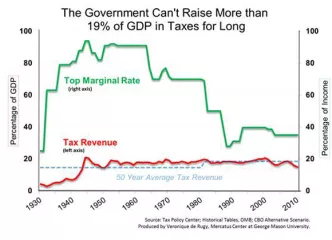- | Government Spending Government Spending
- | Data Visualizations Data Visualizations
- |
The Road to Higher Revenue: Not Necessarily Through Higher Top Marginal Rates
As we move closer to the fiscal cliff and the deficit-reduction talks, it is critical to keep the history of U.S. revenues in mind. Historically speaking, changes to the top marginal income tax rate haven't necessarily had the expected effect on tax revenue under the current tax system. One reason may be that what the government takes with one hand, it gives back with the other. For instance, the government may increase rates but carve the tax base. Another reason, of course, is that there are probably dynamtic economic effects due to the change in the marginal rate.
As we move closer to the fiscal cliff and the deficit-reduction talks, it is critical to keep the history of U.S. revenues in mind. Historically speaking, changes to the top marginal income tax rate haven't necessarily had the expected effect on tax revenue under the current tax system. One reason may be that what the government takes with one hand, it gives back with the other. For instance, the government may increase rates but carve the tax base. Another reason, of course, is that there are probably dynamtic economic effects due to the change in the marginal rate.
To illuminate this fact, the chart below compares the trend lines for federal tax revenue as a percentage of GDP (in red, left axis), using the earliest available records from the Office of Management and Budget, and for the top marginal tax rate (in green, right axis), using data from the Tax Policy Center.
From 1930 to 2012, tax revenue has never topped 20.9 percent of GDP, and over those 82 years, it averaged 16.5 percent of GDP. Since 1981, it has remained below 19 percent on average (see dotted blue line).
In stark contrast, the rate of income taxation on the highest-earning Americans has fluctuated dramatically—from 25 percent of income in 1930 to 92 percent of income in the early 1950s. In spite of these fluctuations in the top marginal rates, the amounts that the federal government has collected have remained flat.
It is spending, not revenue, that has deviated from its historical path. Spending must be addressed to rectify the ailing budget.



